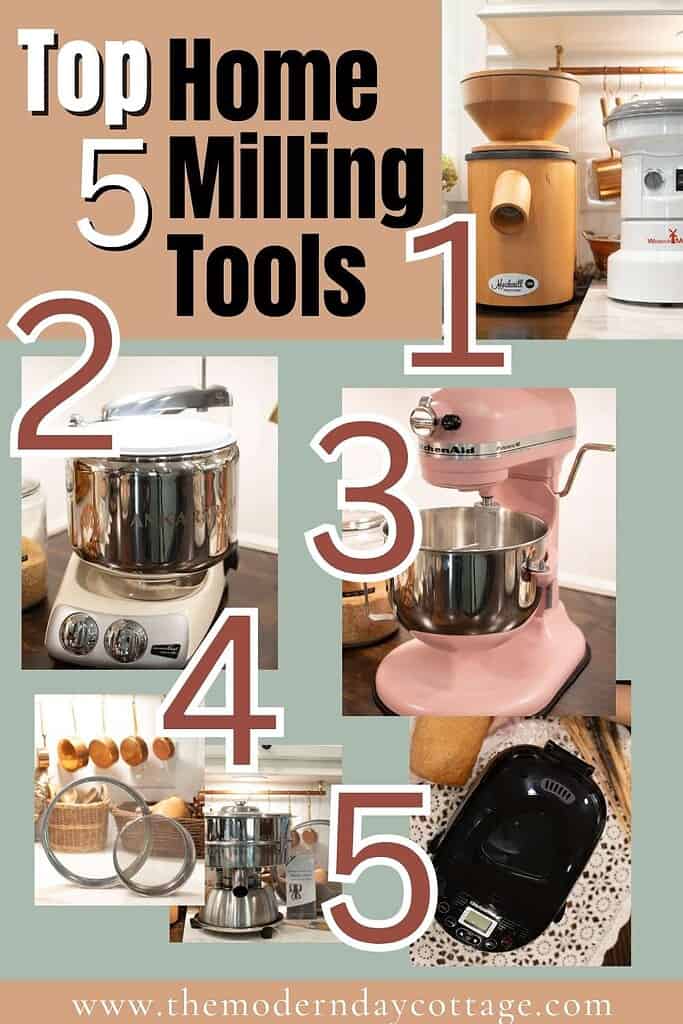Whole grains to use for milling flour include a wide variety of wheat and non-wheat options that each bring their own strengths to baking. Choosing the right grain for your home-milled flour sets the tone for flavor, texture, and nutritional value in every recipe.

Baking with whole grains can enhance the flavor and texture of your recipes. Milling your own whole wheat flour also helps retain more of the natural components found in whole grains, like fiber and nutrients, which may be reduced in commercial flour.
Compared to store-bought flour from the grocery store, fresh milled flour delivers more flavor, more nutrients, and more control over the final product.
Whether you’re using soft white wheat for quick breads or hard red wheat for sourdough bread, choosing the right type of wheat berries impacts both structure and taste.
Many home bakers choose to buy their whole wheat berries in gallon buckets with Gamma lids for longer shelf life and better savings.
When selecting either a high-protein content grain like hard wheat berries or a low-gluten option like soft wheat berries, your baking results will reflect those choices.
You can use a manual grain mill (often called hand mills) or an electric mill, even a coffee grinder to produce fine flour for your bakes, depending on your kitchen setup and preferences.
With thoughtful home milling techniques, you can grind flour on demand or mill in advance.
Storing the flour using safe grain storage methods like mylar bags, freezing for long-term storage, or refrigerating for short-term use.
I use food grade 5 gallon buckets(with gamma lids and oxygen absorbers), mylar bags, and mason jars for storing my whole wheat berries for short and long-term storage.
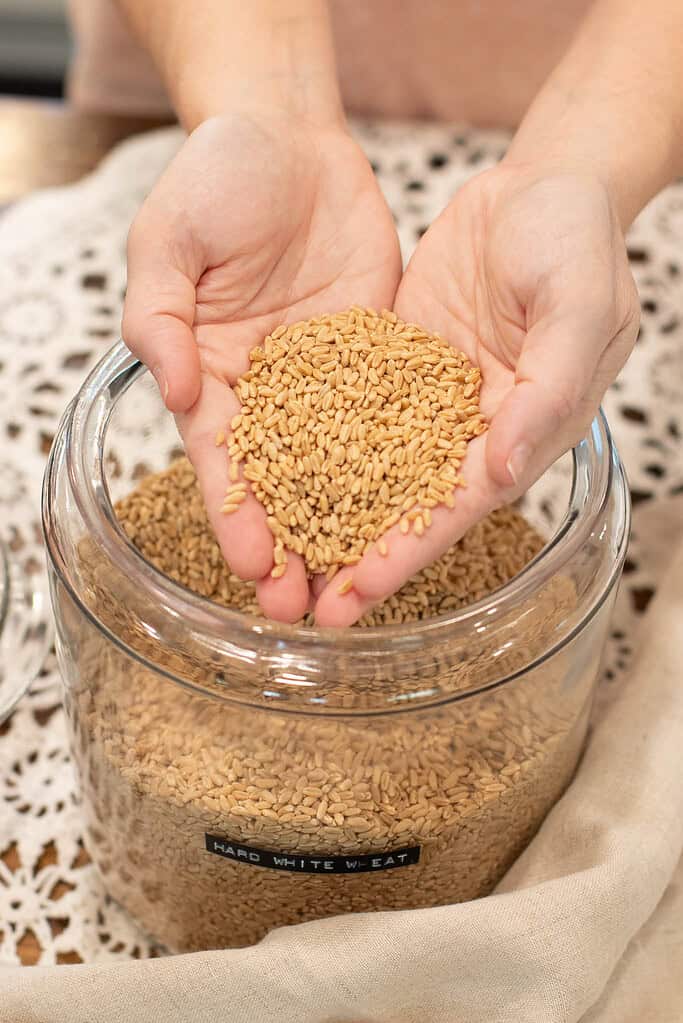
What Are Whole Grains & Wheat Berries?
Whole grains are the entire grain kernel—the bran, germ, and endosperm—all left intact. Wheat berries are the whole form of wheat, and when milled at home, they produce flour that’s alive with flavor, texture, and nutrition.
It’s the kind of ingredient that makes a difference you can actually taste.
Whole grains contain fiber, vitamins, and minerals naturally found in the bran and germ. These parts are often removed in the process of making refined flour, so fresh milling can help retain more of the original grain’s nutrients.
If you’re exploring DIY flour milling or just curious about bakes (what works best) due to gluten levels in whole grains, you’re in good company here.
P.S. I’ll be sharing where to buy wheat berries and other whole grains in my next post, followed by easy tips for storing them long-term and short-term, so be sure to check back soon!
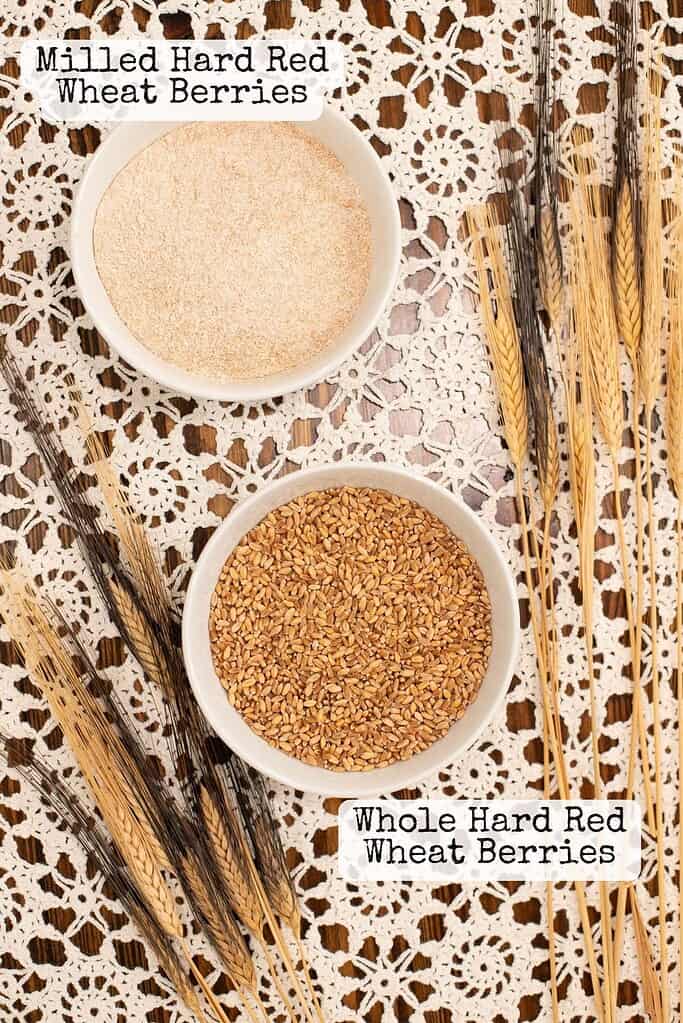
Hard Red Wheat Berries
- Best for: Rustic sourdough, artisan boules, crusty bread
- Protein Content: 12–15%
- Moisture Level: Low (10–12%)
Why You’ll Love Hard Red Wheat Berries
This wheat is bold, hearty, and dependable. It’s packed with gluten strength, making it perfect for chewy loaves with depth. If you love classic healthy homemade bread or old-world style baking, this one’s for you.
Mix hard and soft wheats for balance: Hard wheat brings protein and strength, while soft wheat adds tenderness. Blending them lets you customize flour for specific uses, like soft sandwich loaves with just enough chew or cookies with a tender bite.
How I Use Hard Red Wheat Berries
I keep hard red wheat berries on hand for wild ferment loaves, especially those that need to hold their shape.
I love it for sourdough, sandwich bread, Irish soda bread (especially when I want a more nutty flavor), and even baguettes.
When I need a strong rise, I sometimes sift out the bran for better lift.
Then repurpose the bran to dust my banneton baskets or mist over shaped dough for a crunchy, golden crust layer you just can’t buy in the stores.
Pro Tip: Mix with hard white wheat berries for a milder flavor—especially great if you’re new to milling or whole grains.
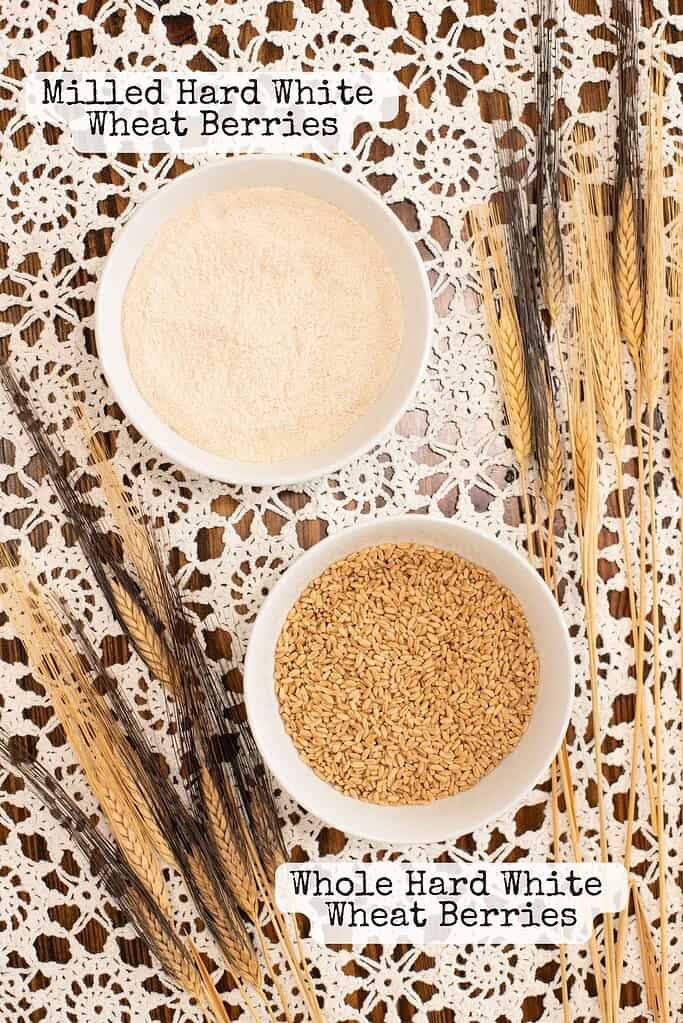
Hard White Wheat Berries
- Best for: Sandwich bread, dinner rolls, soft loaves
- Protein Content: 10–13%
- Moisture Level: Low (10–12%)
Why You’ll Love Hard White Wheat Berries
All the strength of hard red wheat, but lighter in flavor and color. It’s the best of both worlds—strong enough to bake a beautiful loaf, but soft and sweet enough that even picky eaters will love it. Great for your go-to whole wheat bread recipe.
Mix hard and soft wheats for balance: Hard wheat brings protein and strength, while soft wheat adds tenderness. Blending them lets you customize flour for specific uses, like soft sandwich loaves with just enough chew or cookies with a tender bite.
How I Use Hard White Wheat Berries
I use hard white wheat the same way I use hard red, but especially when I want the bread to stay in the background and let fillings shine, like in a sourdough panini or deli sandwich.
It’s also perfect for people who are new to whole wheat baking.
I love it in many soft loaves, sourdough king cakes, and dinner rolls.
I also use this grain to blend up my own bread flour, mixing it with red and soft white wheat. (Stay tuned for an upcoming post on blending wheat berries to recreate flour types like bread, cake, and all-purpose!)

Soft White Wheat Berries
- Best for: Muffins, pancakes, cakes, galettes
- Protein Content: 8.5–10.5%
- Moisture Level: Low (10–12%)
Why You’ll Love Soft White Wheat Berries
Soft white wheat is gentle and sweet. It has lower gluten content, so it won’t produce stretchy bread doughs, but it’s ideal for everything tender and light.
I’m using it in both a chocolate sourdough cake and a cherry galette—recipes coming soon!
For my Sourdough Vanilla Freshly Milled Cake recipe, I use soft white wheat.
This recipe is a keeper if you’re searching for a white cake base recipe for your recipe collection!
Mix hard and soft wheats for balance: Hard wheat brings protein and strength, while soft wheat adds tenderness. Blending them lets you customize flour for specific uses, like soft sandwich loaves with just enough chew or cookies with a tender bite.
How I Use Soft White Wheat Berries
I always sift it for delicate bakes like cakes or pastries, where I want that cake-flour texture.
But for muffins and pancakes, I leave the bran in—it adds depth and nutrition without affecting the soft texture too much.
Soft Red Wheat Berries
- Best for: Cookies, brownies, quick breads
- Protein Content: 8.5–10.5%
- Moisture Level: Low (10–12%)
Why You’ll Love Soft Red Wheat Berries
Think of this one like soft white wheat with a touch more earthiness. It’s perfect for cozy bakes with a nostalgic feel—like spice cake, molasses cookies, or skillet cornbread.
How I Use Soft Red Wheat Berries
I love this for brownies, cookies, and quick breads. It has just a touch more protein than soft white wheat, giving it slightly more structure without getting tough.
It’s excellent for baked goods that use leavening agents and don’t require gluten development.
Mix hard and soft wheats for balance: Hard wheat brings protein and strength, while soft wheat adds tenderness. Blending them lets you customize flour for specific uses, like soft sandwich loaves with just enough chew or cookies with a tender bite.
Pro Tip: Mix with soft white wheat for balanced flavor and structure—especially in muffins, quick breads, and breakfast treats. Or go all in and use 100 percent soft red for a nutty flavor. This one is Sue Beckers favorite to use in her baked goods that don’t need to rise.


Ancient & Specialty Grains to Try in Home Milling
- Best for: Flatbreads, muffins, hearty loaves
Ancient grains bring something sacred to the table—a depth of flavor and a story in every bite. They’re lower in gluten, so they often need blending or pan support, but their richness is worth it. If you’re curious about ancient grain nutrition, these are great additions.
- Einkorn: Soft and buttery, delicate structure
- Spelt: Slightly sweet, easy to digest
- Kamut: Buttery, golden, with lovely chew
- Emmer: Nutty and firm, full of old-world charm
- Rye: Bold and tangy, for hearty, dense breads like rye bread
- Buckwheat: Gluten-free and earthy, ideal for pancakes
Why You’ll Love These Grains:
They deepen flavor, add character, and nourish both body and tradition.
They’re perfect for experimenting and creating blends that feel personal and full of whole food goodness.
I store them in mason jars and large glass lidded jars with wooden scoops for everyday access. I reach most often for einkorn, kamut, spelt, and rye.
Often, I make recipes using buckwheat for pancakes and a bit in quick bread blends.

PRINTABLE: 🌾 Grains at a Glance🌾
This printable chart is a helpful kitchen companion for choosing the right grain for your favorite bakes. It highlights the best uses, protein content, and unique flavor notes of each grain—making it easier to select the perfect wheat or ancient grain for everything from sourdough to muffins.
✨ Want more printable charts and cozy Cottage Living lifestyle freebies?
Join our Cottage Living Community and get instant access to the VIP Password Printable Subscriber Page, filled with helpful downloads to support your from-scratch baking journey.
A Note on Nutrition
Protein levels and grain behavior can vary with season and region. The numbers here are common ranges, but there’s always room for variation—nature’s little surprise. Curious about home milling techniques or choosing the best wheat berries for milling? Start with simple recipes and build confidence with every bake.
For deeper insight into nutrition about flour milling, I personally follow Sue Becker of The Bread Beckers. She’s a certified nutritionist and a respected educator in the home milling flour community.
🌾 Keep Your Flour Milling Journey Going 🌾
If you’re just getting started with home milling or looking to expand your skills, you’re in the right place! Be sure to check out these foundational posts to help you feel confident and equipped:
01. Beginner’s Guide to Milling Fresh Flour at Home
02. My Five Favorite Tools for Milling Fresh Flour at Home
I’ve mapped out this full home milling series based on the exact questions I’ve been asked over the years.
These posts are being released one at a time—slowly and intentionally—with real-life experience at the center of every post.
You’ll soon have everything you need—from sourcing and storing to baking and blending—so you can get the most out of your freshly milled grains and create nourishing bakes with confidence.
Continue Your Freshly Milled Flour Journey
If you’re anything like me, you want to know A to B and every why and how when I am learning a new skill, whether it’s in the kitchen or in the garden.
I love those tiny but mighty details, and it helps me troubleshoot on my own if I know all the ins and outs. I hope these posts help with just that when it comes to Freshly Milled Flour information. More to come soon…..
- #01. Beginner’s Guide to Freshly Milled Flour at Home
- #02. My Top 5 Favorite Tools for Milling Fresh Flour at Home
- #03. What Whole Grains to Use for Milling Flour at Home
- #04. Tips for Converting Recipes to Freshly Milled Flour
- #05. Sifting Fresh Milled Flour: When It Matters Most
- #06. Bread Flour Blend Using Freshly Milled Wheat Berries
- #07. Soft Wheat Blends for Homemade Cake And Pastry Flour
- #08. Blending Wheat Berries for Homemade All-Purpose Flour
- #09. Baking Sourdough with Freshly Milled Flour at Home
- #10. Where To Buy Wheat Berries And Other Whole Grains

FAQs: Whole Grains to Use for Milling Flour
Why does freshly milled flour act differently?
Freshly milled flour contains all parts of the grain—bran, germ, and endosperm—so it absorbs more water than commercial flour. It also behaves more “alive” in dough, which means it may rise faster or ferment more actively than aged or processed flour.
Do I need to sift?
Sifting is optional but helpful depending on your bake. For cakes, cookies, and soft pastries, sifting removes the larger bran pieces and results in a tender crumb. For rustic or whole grain loaves, I often keep the bran in or use it for other parts of the bake, like dusting bannetons or topping loaves.
Can I use it right away?
Yes! Many home bakers use it immediately. Some choose to let it oxidize for 12–24 hours to help it strengthen gluten development, but I personally use mine right after milling and have never had a problem.

How do I store fresh flour?
If you’re using it the same day, you can leave it at room temperature. For longer storage, keep it in an airtight container in the refrigerator for up to a week, or in the freezer for longer-term freshness. Mylar bags and vacuum-sealed jars also work well for bulk storage.
Are all grains gluten-free?
No. Only certain grains like buckwheat, millet, and amaranth are naturally gluten-free. Always double-check sourcing and processing methods to avoid cross-contamination if you have gluten sensitivity or Celiac disease.

Tips for Baking with Freshly Milled Flour
- Let your dough rest—hydration is key: Giving your dough time to rest allows the flour to fully absorb the water, making it easier to work with and improving texture. This rest period, especially after mixing, helps gluten develop naturally without over-kneading.
- Try autolyse for gluten strength: Combine just flour and water and let it sit for 20–60 minutes before adding salt and yeast. This simple step can dramatically improve dough extensibility, crumb structure, and flavor, especially in artisan breads.
- Mix hard and soft wheats for balance: Hard wheat brings protein and strength, while soft wheat adds tenderness. Blending them lets you customize flour for specific uses, like soft sandwich loaves with just enough chew or cookies with a tender bite.
- Keep notes of what works (and what doesn’t!): Milling and baking are both part science and part art. Keep a simple log of your grain types, hydration ratios, rest times, and results. This will help you refine your process and avoid repeating mistakes.
- Sift for fine cakes and pastries: Sifting aerates the flour and removes coarse bran, giving cakes, muffins, and pastries a finer, lighter texture. This is especially helpful when using freshly milled whole grain flours.
- Choose the best grain mill for your needs—check home grain mill reviews before buying: Whether you’re after speed, stone-ground texture, or adjustable fineness, there’s a mill for every style. Research reviews and think about what you’ll be using it for most often—breads, pasta, pastries, or a bit of everything.

You Deserve to Feel Confident in the Kitchen Using Whole Grains for Milling Flour
If you’re looking to bring more intention, nourishment, and old-world charm to your baking, you’re in the right place.
With over 25 years of hands-on experience milling and baking in my cottage kitchen, I’ve learned what truly works, not just from books, but from a life using whole grain flours in my home.
Every tip I share comes from real-life experience, traditions passed down, and the lessons learned one loaf at a time.
While I’m not a certified nutritionist, I encourage you to consult with health professionals for personalized advice.
My goal is to help you feel equipped, encouraged, and inspired to use freshly milled flour in your own home, because the best bread isn’t just about ingredients.
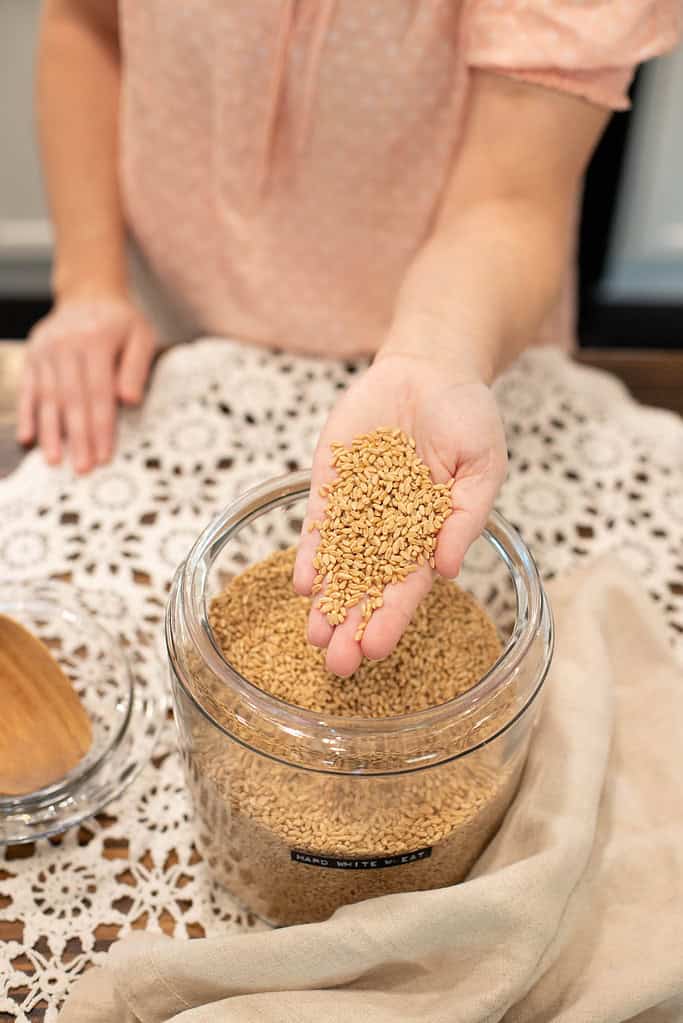
Want to keep learning about Whole Grains to Use for Milling Flour?
Join our cozy corner of the cottage community and get updates on fresh flour recipes, cottage living inspiration, and cozy decor. Whether you’re here to master your first sourdough loaf or simply reconnect with homemade food, there’s space for you at the table.
Tag your beautiful bakes on Instagram @themoderndaycottage—we love celebrating your creations and sharing your stories.
Just beginning your journey with whole grains? I’d love to hear what questions you have.
I’m here to guide you and walk you through it, one step at a time.
“This isn’t just a return to the past—it’s a meaningful step forward, one freshly milled cup of flour at a time.” -Emily Rider
Disclaimer: This post shares and reflects my personal experience baking with freshly milled flour at home for over 25+ years. It is intended for informational and inspirational purposes only. Please use your best judgment and consult a qualified professional for any dietary or health-related advice.


